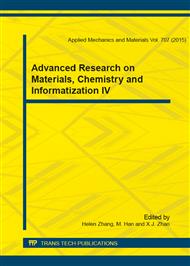[1]
Zhang C., Li G. L., Xiao Y. Q., Li L., Pang Z. Two new glycosides from the seeds of Cassia obtusifolia. Chinese Chemical Letters, 20(9): 1097-1099. (2009).
DOI: 10.1016/j.cclet.2009.04.006
Google Scholar
[2]
Tzeng T. F., Lu H. J., Liou S. S., Chang C. J., Liu I. M. Cassia tora (leguminosae) seed extract alleviates high-fat diet-induced nonalcoholic fatty liver. Food and Chemical Toxicology, 51, 194-201. (2013).
DOI: 10.1016/j.fct.2012.09.024
Google Scholar
[3]
Xiao W., Han L., Shi B. Microwave-assisted extraction of flavonoids from Radix Astragali. Separation and Purification Technology, 62(3), 614-618. (2008).
DOI: 10.1016/j.seppur.2008.03.025
Google Scholar
[4]
Puri M., Sharma D., Barrow C. J. Enzyme-assisted extraction of bioactives from plants. Trends in biotechnology, 30(1): 37-44. (2012).
DOI: 10.1016/j.tibtech.2011.06.014
Google Scholar
[5]
LI M. F., LI S. F., WANG X. Q., RUAN H. Q. Analysis and extractions of bio-flavonoid from Lycium Barbarum. Tianjin Agricultural Sciences, 17(1): 46-50. (2011).
Google Scholar
[6]
Hemwimon S., Pavasant P., Shotipruk A., Microwave-assisted extraction ofantioxidative anthraquinones from roots of Morinda citrifolia. Separation and Purification Technology, 25, 192–199. (2006).
DOI: 10.1016/j.seppur.2006.08.014
Google Scholar
[7]
Li H., Bo C., Zhang Z., Yao S., Focused microwave-assisted solvent extractionand HPLC determination of effective constituents in Eucommia ulmodies Oliv. (E. ulmodies). Talanta, 63, 659–665. (2004).
DOI: 10.1016/j.talanta.2003.12.028
Google Scholar
[8]
Guo Z., Jin Q., Fan G., Duan Y., Qin C., Wen M., Microwave-assisted extractionof effective constituents from a Chinese herbal medicine Radix puerariae. Analytica Chimica Acta, 436, 41–47. (2001).
DOI: 10.1016/s0003-2670(01)00900-x
Google Scholar
[9]
Rostagno M.A., Palma M., Barroso C.G., Ultrasound-assisted extraction of soy isoflavones. Journal of Chromatography A, 1012(2): 119–128. (2003).
DOI: 10.1016/s0021-9673(03)01184-1
Google Scholar
[10]
Chen Y., Xie M.Y., Gong X. F. Microwave-assisted extraction used for the isolation of total triterpenoid saponins from Ganoderma atrum. Journal of Food Engineering, 81, 162–170. (2007).
DOI: 10.1016/j.jfoodeng.2006.10.018
Google Scholar
[11]
Eskilsson C. S., Björklund E. Analytical-scale microwave-assisted extraction. Journal of Chromatography A, 902, 227–250. (2000).
DOI: 10.1016/s0021-9673(00)00921-3
Google Scholar
[12]
Camel V. Microwave-assisted solvent extraction of environmental samples. Trends in Analytical Chemistry, 19(4): 229–248. (2000).
DOI: 10.1016/s0165-9936(99)00185-5
Google Scholar


